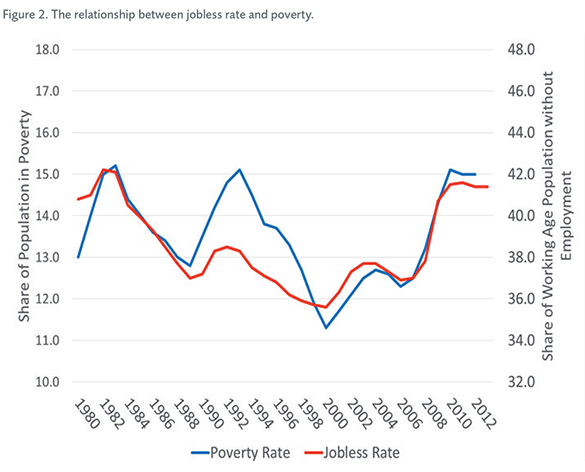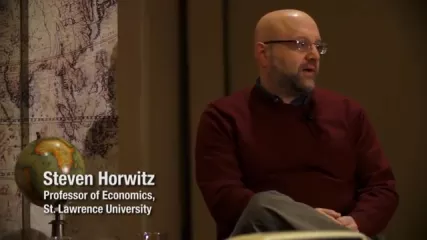- | Government Spending Government Spending
- | Federal Testimonies Federal Testimonies
- |
Opportunity, Mobility, and Inequality in Today’s Economy
Testimony Before the Senate Budget Committee
Raising the rate of labor force participation needs to be a central focus of federal policymakers, in order to strengthen our economy and raise the prospects of low-income Americans. To do this, we need to make it easier, not harder, for companies to increase hiring. We also need to encourage individuals to re-enter the labor force, not discourage them. Government assistance for the jobless is important, but the re-employment of the jobless is what we need to reduce poverty and lower income inequality.
Chairwoman Murray, Ranking Member Sessions, and members of the Committee: Thank you for the invitation to discuss income inequality and today’s economy. I appreciate the opportunity to testify today.
Nearly five years after the end of the Great Recession, the labor market today is still far from full recovery. At just 58.8 percent, the share of the working-age population with employment is still below what it was in 2009. Inadequate growth is at the heart of this poor recovery. We have, in fact, been very fortunate to get a relatively modest level of job creation given the fact that the economy has grown at an average annual rate of just 1.6 percent over the past three years.
The problem of this inadequate job growth for everyone in America can be explained as follows:
- We have seen an unprecedented disengagement from the labor force since the end of the recession. Last year, labor force participation was at its lowest level in 35 years. This is, I believe, the biggest ongoing economic challenge that we face today.
- Unless we stop this trend and begin to bring back the millions of Americans who are no longer in the labor force, we will have permanently lower economic growth, slower income growth, and rising income inequality.
- In order to assist American families to escape poverty, we must focus on policies that support employment by encouraging economic growth, lowering the cost of hiring for employers, and increasing incentives to re-enter the labor force.
Labor Force Disengagement
The adverse effects of joblessness are real for American families. It is well established that individuals experiencing job loss have large and persistent earnings losses for years afterwards. Recent estimates find that, on average, lower earnings will continue for nearly 20 years. Further, the impact on the long-term jobless is even more severe and millions of jobless today stand the real risk of never returning to the labor force.Since the beginning of the recession, participation in the labor force has fallen to just 63 percent. This is the equivalent of a withdrawal of nearly 7.5 million people. While some of this decline was expected and is due to an aging population, most was not. In 2013, labor force participation was at a 20-year low or longer for every age range between 20 and 54 years old. (See figure 1.) Fully eliminating the effect of our aging baby boomers reaching retirement, I estimate that the labor force is currently short over 4.5 million people.
This unprecedented disengagement from the labor force has serious implications for the economy. Using CBO’s methodology, this 4.5 million-person shortfall in the labor force last year alone was equivalent to a $500 billion shortfall in potential national income. This is a 3.0 percent loss of income for American families.
The problem of disengagement from the labor force needs urgent attention. It has always been true that the longer an individual is out of the labor force, the less likely they are to return to employment. With four million long-term unemployed and likely millions more long-term jobless, this disengagement may already be permanently effecting our labor force, and we could have a permanently smaller workforce. This, I believe, is the biggest threat to improving income inequality in the United States.
Employment and Poverty
Despite the end of the recession in 2009 and a dramatic increase in government spending on means-tested programs, there were still a record 46 million people living in poverty in 2012. Federal spending alone on these programs was $750 billion in FY 2011, up over 30 percent from FY 2008. Lack of employment is the primary cause of this poverty. Most of those aged 18 to 64 years old who were in poverty didn’t have as much as a single week of employment in 2012. Only about 11 percent had full-time employment.
Government spending does not move people out of poverty—jobs do. We have never had a decline in the poverty rate that wasn’t associated with a rise in the rate of employment. Since the late 1990s, employment appears to be the only thing that reliably reduces poverty. (See figure 2.)
We should focus on jobs if our goal is to have a significant impact on income inequality in the United States in the near term. We should be encouraging hiring by helping to lower the cost of hiring to firms. Similarly, we should be encouraging disengaged workers to re-enter the labor force. Policies that either raise the cost of hiring or reduce the incentive for work are counterproductive. They often can even contribute to income inequality by contributing to disengagement from the labor force.
For example, the proposal to raise the minimum wage from $7.25 to $10.10 an hour may have the perverse and unintended effect of increasing income inequality in the United States. It is, of course, a laudable goal to see wages increase, particularly for those who could benefit the most from the raise. However, forcing employers to pay more to low-skilled workers could mean job losses for a group that is already having trouble finding work and fewer hours for a sector of the labor market that mainly works part-time.
No matter what you’ve heard about the effects of raising the federal minimum wage, there is a significant amount of economic research that finds raising the minimum wage only benefits some workers at the expense of jobs for others—particularly the least skilled and experienced workers. The current proposal represents a huge, 39 percent increase in hourly wage cost of hiring for many. Common sense dictates that raising the cost of hiring the least skilled workers will force employers to look to substitutes like higher skilled workers or rapidly advancing technology.
In 2013, there were 8.8 million people making between $7.25 and $8.25 an hour. I’ll call these the “near-minimum-wage” earners. These are the least experienced and least skilled of our workforce. Most are under the age of 25 and have no more than a high school diploma. The biggest economic problem for this group is securing employment of any type. Less than half are even in the labor force, and for those that are, the unemployment rate is 21.7 percent—well over three times the national average.
The Congressional Budget Office also recognizes that raising the minimum wage would only benefit some workers at the expense of jobs for others. They estimated that half a million people will lose their jobs as a result of increasing the minimum wage to $10.10. These “near-minimum-wage” earners would be the ones paying the price of job loss because we raised their cost of hiring by nearly 40 percent.
Another example of a policy that will contribute to our problem of disengagement from the labor force is the Affordable Care Act. CBO’s recent finding that the Affordable Care Act will significantly reduce the incentive to work by the equivalent of more than 2 million full-time workers in just a few years is deeply concerning.
More generally, raising the regulatory burden for companies while we have a struggling labor market is counterproductive. While new regulations may be important, they raise the cost of production and therefore the cost of hiring production workers. Many of these workers have below-average wages to begin with, and in a bad labor market, job loss is much costlier for affected families.
Raising the rate of labor force participation needs to be a central focus of federal policymakers, in order to strengthen our economy and raise the prospects of low-income Americans. To do this, we need to make it easier, not harder, for companies to increase hiring. We also need to encourage individuals to re-enter the labor force, not discourage them. Government assistance for the jobless is important, but the re-employment of the jobless is what we need to reduce poverty and lower income inequality.




